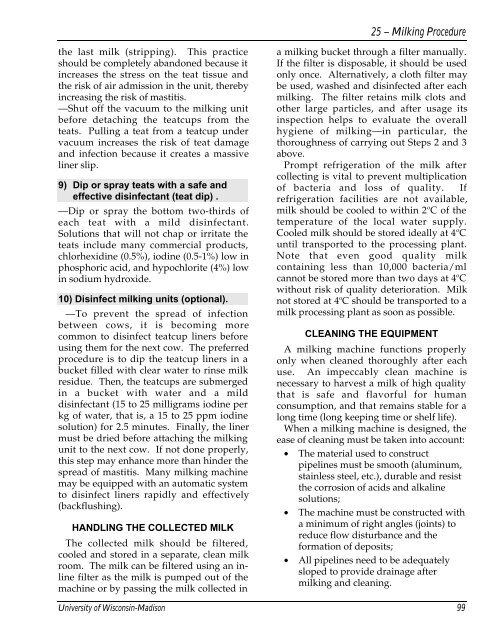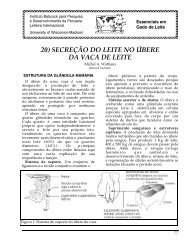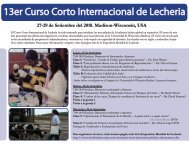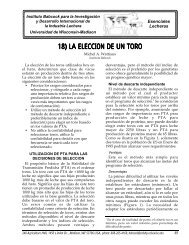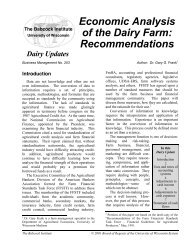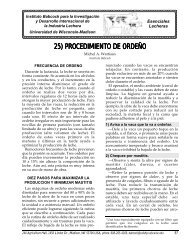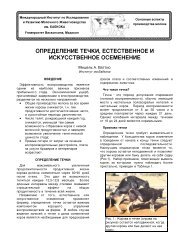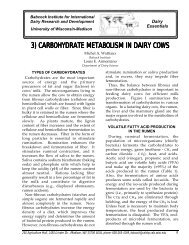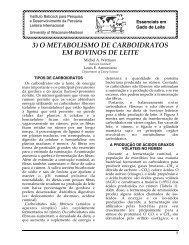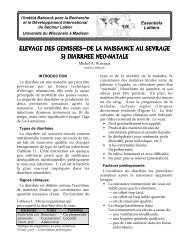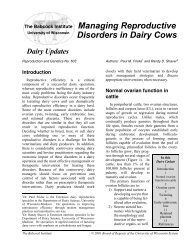25) milking procedure - Babcock Institute - University of Wisconsin ...
25) milking procedure - Babcock Institute - University of Wisconsin ...
25) milking procedure - Babcock Institute - University of Wisconsin ...
You also want an ePaper? Increase the reach of your titles
YUMPU automatically turns print PDFs into web optimized ePapers that Google loves.
<strong>25</strong> – Milking Procedurethe last milk (stripping). This practiceshould be completely abandoned because itincreases the stress on the teat tissue andthe risk <strong>of</strong> air admission in the unit, therebyincreasing the risk <strong>of</strong> mastitis.—Shut <strong>of</strong>f the vacuum to the <strong>milking</strong> unitbefore detaching the teatcups from theteats. Pulling a teat from a teatcup undervacuum increases the risk <strong>of</strong> teat damageand infection because it creates a massiveliner slip.9) Dip or spray teats with a safe andeffective disinfectant (teat dip) .—Dip or spray the bottom two-thirds <strong>of</strong>each teat with a mild disinfectant.Solutions that will not chap or irritate theteats include many commercial products,chlorhexidine (0.5%), iodine (0.5-1%) low inphosphoric acid, and hypochlorite (4%) lowin sodium hydroxide.10) Disinfect <strong>milking</strong> units (optional).—To prevent the spread <strong>of</strong> infectionbetween cows, it is becoming morecommon to disinfect teatcup liners beforeusing them for the next cow. The preferred<strong>procedure</strong> is to dip the teatcup liners in abucket filled with clear water to rinse milkresidue. Then, the teatcups are submergedin a bucket with water and a milddisinfectant (15 to <strong>25</strong> milligrams iodine perkg <strong>of</strong> water, that is, a 15 to <strong>25</strong> ppm iodinesolution) for 2.5 minutes. Finally, the linermust be dried before attaching the <strong>milking</strong>unit to the next cow. If not done properly,this step may enhance more than hinder thespread <strong>of</strong> mastitis. Many <strong>milking</strong> machinemay be equipped with an automatic systemto disinfect liners rapidly and effectively(backflushing).HANDLING THE COLLECTED MILKThe collected milk should be filtered,cooled and stored in a separate, clean milkroom. The milk can be filtered using an inlinefilter as the milk is pumped out <strong>of</strong> themachine or by passing the milk collected ina <strong>milking</strong> bucket through a filter manually.If the filter is disposable, it should be usedonly once. Alternatively, a cloth filter maybe used, washed and disinfected after each<strong>milking</strong>. The filter retains milk clots andother large particles, and after usage itsinspection helps to evaluate the overallhygiene <strong>of</strong> <strong>milking</strong>—in particular, thethoroughness <strong>of</strong> carrying out Steps 2 and 3above.Prompt refrigeration <strong>of</strong> the milk aftercollecting is vital to prevent multiplication<strong>of</strong> bacteria and loss <strong>of</strong> quality. Ifrefrigeration facilities are not available,milk should be cooled to within 2 o C <strong>of</strong> thetemperature <strong>of</strong> the local water supply.Cooled milk should be stored ideally at 4 o Cuntil transported to the processing plant.Note that even good quality milkcontaining less than 10,000 bacteria/mlcannot be stored more than two days at 4 o Cwithout risk <strong>of</strong> quality deterioration. Milknot stored at 4 o C should be transported to amilk processing plant as soon as possible.CLEANING THE EQUIPMENTA <strong>milking</strong> machine functions properlyonly when cleaned thoroughly after eachuse. An impeccably clean machine isnecessary to harvest a milk <strong>of</strong> high qualitythat is safe and flavorful for humanconsumption, and that remains stable for along time (long keeping time or shelf life).When a <strong>milking</strong> machine is designed, theease <strong>of</strong> cleaning must be taken into account:• The material used to constructpipelines must be smooth (aluminum,stainless steel, etc.), durable and resistthe corrosion <strong>of</strong> acids and alkalinesolutions;• The machine must be constructed witha minimum <strong>of</strong> right angles (joints) toreduce flow disturbance and theformation <strong>of</strong> deposits;• All pipelines need to be adequatelysloped to provide drainage after<strong>milking</strong> and cleaning.<strong>University</strong> <strong>of</strong> <strong>Wisconsin</strong>-Madison 99


